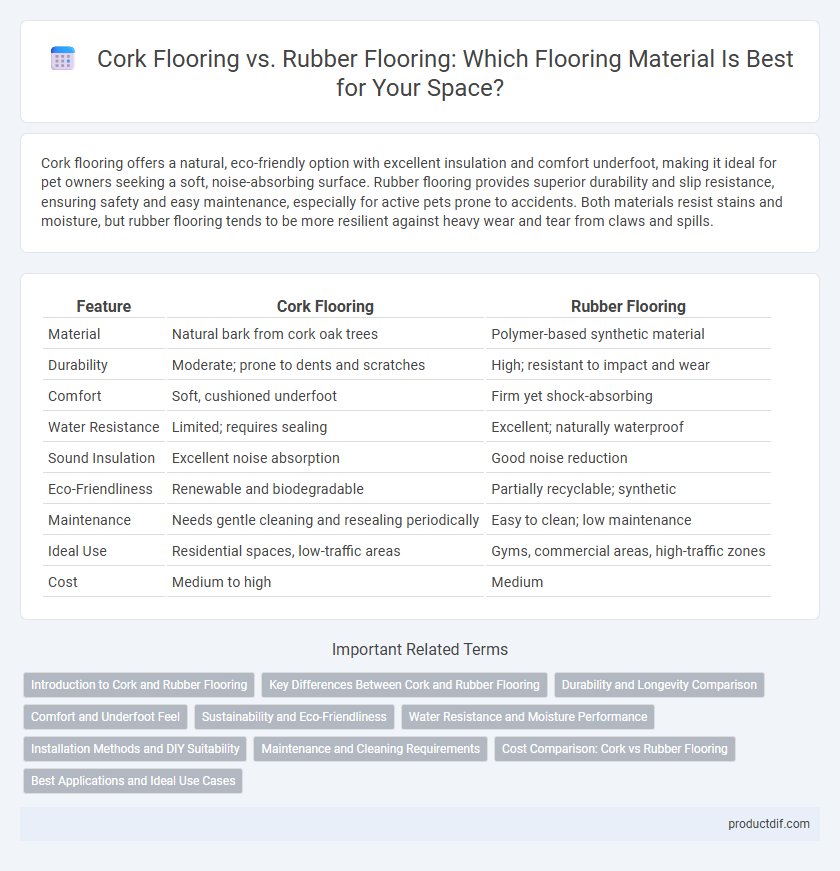Cork flooring offers a natural, eco-friendly option with excellent insulation and comfort underfoot, making it ideal for pet owners seeking a soft, noise-absorbing surface. Rubber flooring provides superior durability and slip resistance, ensuring safety and easy maintenance, especially for active pets prone to accidents. Both materials resist stains and moisture, but rubber flooring tends to be more resilient against heavy wear and tear from claws and spills.
Table of Comparison
| Feature | Cork Flooring | Rubber Flooring |
|---|---|---|
| Material | Natural bark from cork oak trees | Polymer-based synthetic material |
| Durability | Moderate; prone to dents and scratches | High; resistant to impact and wear |
| Comfort | Soft, cushioned underfoot | Firm yet shock-absorbing |
| Water Resistance | Limited; requires sealing | Excellent; naturally waterproof |
| Sound Insulation | Excellent noise absorption | Good noise reduction |
| Eco-Friendliness | Renewable and biodegradable | Partially recyclable; synthetic |
| Maintenance | Needs gentle cleaning and resealing periodically | Easy to clean; low maintenance |
| Ideal Use | Residential spaces, low-traffic areas | Gyms, commercial areas, high-traffic zones |
| Cost | Medium to high | Medium |
Introduction to Cork and Rubber Flooring
Cork flooring is made from the bark of the cork oak tree, known for its natural resilience, thermal insulation, and eco-friendly properties. Rubber flooring, derived from natural or synthetic rubber, offers exceptional durability, slip resistance, and shock absorption, making it ideal for high-traffic and commercial areas. Both flooring types provide unique benefits, with cork emphasizing sustainability and warmth, while rubber excels in longevity and safety features.
Key Differences Between Cork and Rubber Flooring
Cork flooring offers natural insulation, eco-friendliness, and a warm, soft texture, making it ideal for residential spaces focused on comfort and sustainability. Rubber flooring excels in durability, slip resistance, and shock absorption, favored in commercial gyms and high-traffic areas for its resilience and easy maintenance. While cork is biodegradable and prone to moisture damage, rubber is waterproof and highly resistant to wear, defining their suitability for different environments.
Durability and Longevity Comparison
Cork flooring offers moderate durability with natural resistance to wear, but it may dent or fade over time in high-traffic areas. Rubber flooring provides superior durability and resilience, with excellent resistance to abrasions, impacts, and moisture, making it ideal for commercial and heavy-use environments. The longevity of rubber flooring generally exceeds cork, lasting up to 20 years or more, while cork typically requires replacement or refinishing after 10 to 15 years.
Comfort and Underfoot Feel
Cork flooring offers exceptional comfort and a warm, cushioned underfoot feel due to its natural cellular structure, which provides excellent shock absorption and thermal insulation. Rubber flooring delivers superior resilience and a firm yet slightly springy surface that reduces fatigue and provides excellent slip resistance, making it ideal for high-traffic areas. Both materials enhance comfort, with cork favored for its softness and natural warmth and rubber prized for durability and impact absorption.
Sustainability and Eco-Friendliness
Cork flooring is harvested from the bark of cork oak trees, which regenerates naturally, making it a highly sustainable and biodegradable material. Rubber flooring, often made from recycled tires or synthetic sources, offers durability but may involve more energy-intensive production and less biodegradability. Both materials provide eco-friendly options, but cork's renewable harvesting process and natural composition give it a stronger edge in environmental sustainability.
Water Resistance and Moisture Performance
Cork flooring offers moderate water resistance due to its natural cellular structure, which repels minor spills but requires sealing for prolonged moisture exposure. Rubber flooring excels in moisture performance with its impermeable surface, making it highly resistant to water infiltration and ideal for wet environments. Both materials demand proper installation and maintenance to prevent moisture-related damage, but rubber flooring provides superior durability in consistently damp conditions.
Installation Methods and DIY Suitability
Cork flooring typically features a floating installation method with click-lock planks, making it highly suitable for DIY projects due to its ease of fitting and minimal subfloor preparation. Rubber flooring often requires adhesive application or interlocking tiles, which can be more complex and time-consuming, potentially necessitating professional installation for optimal results. Both materials demand clean, dry, and level subfloors, but cork's lighter weight and flexibility enhance its appeal for home installers.
Maintenance and Cleaning Requirements
Cork flooring requires gentle cleaning with a damp mop and pH-balanced cleaners to maintain its natural finish and prevent damage, while avoiding excessive water exposure that can cause swelling. Rubber flooring is highly durable and easy to clean, typically needing only regular sweeping and occasional mopping with mild detergent to prevent dirt buildup and maintain its slip-resistant surface. Both materials benefit from prompt spill cleanup and routine maintenance to extend their lifespan and preserve appearance.
Cost Comparison: Cork vs Rubber Flooring
Cork flooring typically costs between $3 and $7 per square foot, making it an affordable and eco-friendly option, while rubber flooring ranges from $2 to $8 per square foot, depending on the quality and thickness. Installation costs for cork tend to be slightly higher due to specialized adhesives, whereas rubber flooring often features interlocking tiles or rolls that reduce labor expenses. Long-term maintenance expenses for both materials are low, but cork may require occasional sealing, impacting overall cost efficiency compared to rubber's durability and resistance to wear.
Best Applications and Ideal Use Cases
Cork flooring excels in residential settings where comfort, insulation, and eco-friendliness are priorities, making it ideal for bedrooms, living rooms, and low-traffic areas. Rubber flooring is best suited for high-traffic commercial spaces, gyms, and play areas due to its durability, slip resistance, and shock absorption. Both materials offer unique benefits tailored to specific environments, with cork providing warmth and sound insulation, while rubber delivers high resilience and easy maintenance.
Cork Flooring vs Rubber Flooring Infographic

 productdif.com
productdif.com